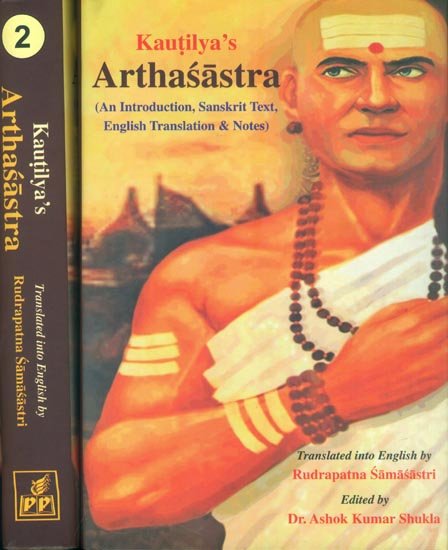Kautilya Arthashastra
by R. Shamasastry | 1956 | 174,809 words | ISBN-13: 9788171106417
The English translation of Arthashastra, which ascribes itself to the famous Brahman Kautilya (also named Vishnugupta and Chanakya) and dates from the period 321-296 B.C. The topics of the text include internal and foreign affairs, civil, military, commercial, fiscal, judicial, tables of weights, measures of length and divisions of time. Original ...
Chapter 17 - The Superintendent of Forest Produce
[Sanskrit text for this chapter is available]
The superintendent of forest produce shall collect timber and other products of forests by employing those who guard productive forests. He shall not only start productive works in forests, but also fix adequate fines and compensations to be levied from those who cause any damage to productive forests except in calamities.[1]
The following are forest products:
Sāka (teak), tiniśa (Dalbergia ougeinensis), dhanvana(?), arjuna (Terminalia arjuna), madhūka (Bassia latifolia), tilaka (Barleria cristata), tāla (palmyra), śiṃśūpa (Daibergia sissu), arimeda (Fetid mimosa), rājādana (Mimosops kauki), śirīṣa (Mimosa siriṣa), khadira (Mimosa catechu), sarala (Pinus longifolia), tālasaṛja (sal tree or Shorea robesta), aśvakarṇa (Vatica robesta), somavalka (a kind of white khādira), kaśāmra (?), priyaka (yellow sal tree), dhava (Mimosa hexandra), etc., are the trees of strong timber (sāradāruvarga).
Uṭaja,[2] Cimiya,[3] Cava, Venu,[4] Vaṃśa,[5] Sātina,[6] Kaṇaka,[7] and Bhāllūka,[8] etc., form the group of bamboo.
Vetra (cane), śokavallī,[9] vāśi[10] (Justicia ganderussa?), śyāmalatā[11] (Ichnocarpus), nāgalata (betel), etc., form the group of creepers.
Mālatī (Jasminum granadiflorum), dūrvā[12] (panic grass), arka (Galotropis gigantea), śaṇa (hemp), gavedhuka (Coix barbata), atasī[13] (Linum usitatis simum), etc., form the group of fibrous plants (valkavarga).
Muñja (Saccharum munja), balbaja (Eleusine Indica), etc., are plants which yield rope-making material (rajjubhāṇḍa).
Tāli (Corypha taliera), tāla (palmyra or Borassus flabelliformis), and bhūrja (birch) yield leaves (patra).[14]
Kiṃśuka (Butea frondosa), kusumbha (Carthamus tinctorius), and kuṅkuma (Crocus sativus) yield flowers.[15]
Bulbous roots and fruits are the group of medicines.
Kālakūṭa,[16] vatsanābha,[17] hālāhala,[18] meṣaśṛṅga,[19] mustā (Cyperus rotimclus)[20], kuṣṭha, mahāviṣa,[21] vellitaka,[22] gaurārdra,[23] bālaka,[24] mārkata,[25] haimavata,[26] kāliṅgaka,[27] daradaka,[28] kolasāraka,[29] uṣṭraka,[30] etc., are poisons.
Likewise snakes and worms kept in pots are the group of poisons.
Skins are those of godha (alligator), seraka (?), dvīpi (leopard), śiṃśumāra (porpoise), siṃha (lion), vyāghra (tiger), hasti (elephant), mahiṣa (buffalo), camara (bos grunniens), gomṛga (bos gavaeus), and gavaya (the gayal).
Bones, bile (pittha), sinew, teeth, horn, hoofs, and tails of the above animals, as well as of other beasts, cattle, birds and snakes (vyāla).
Kālāyasa (iron), tāmra (copper), vṛtta (?), kāṃsya (bronze), sīsa (lead), trapu (tin), vaikṛntaka (mercury?), and ārakūṭa (brass), are metals.
Utensils (bhāṇḍa) are those made of cane, bark (vidala), and lay (mṛttikā).
Charcoal, bran, and ashes are other things.
Menageries of beasts, cattle, and birds.
Collection of firewood and fodder.
The superintendent of forest produce shall carry on, either inside or outside (the capital city), the manufacture of all kinds of articles which are necessary for life or for the defence of forts.[31]
[Thus ends Chapter XVII, “The Superintendent of Forest Produce,” in Book II, “The Duties of Government Superintendents” of the Arthaśāstra of Kauṭilya. End of thirty-eighth chapter from the beginning.]
Footnotes and references:
[1]:
Cutting and carrying off branches of such trees as would be useful for axles of cart, etc., is no offence.—Com.
[2]:
A kind of bamboo, very hollow, of soft thorns, and very hard in lower portions—Com.
[3]:
Cimaya (so reads the commentator) is not hollow, but is of soft bark and possesses no thorns.—Com.
[5]:
Vaṃśa has thorns and the space between any two of its knots is long.—Com.
[6]:
Sātina is smaller than Vaṃśa.—Com.
[7]:
Kunaṭṭa (so reads the commentator) is very big and bears seeds like wheat.—Com.
[8]:
Halluka (the reading of the Com.) is very big, long and has no thorns.—Com.
[9]:
Hiṃsavallī is another name for the same.—Com.
[10]:
This bears flowers like those of Arjuna.—Com.
[11]:
This is like trivrit (Convolvulus turpethum).—Com.
[12]:
Murva (the reading of the Com.), i.e. Sanseveira roxiburghiana.—Com.
[13]:
Avataṃsi or Vataṃsi appears to be the reading of the Commentator.
[14]:
Writing material.—Com.
[15]:
Flowers productive of colouring material.—Com.
[16]:
Its leaves are like those of fig tree; the gum-like secretion of this is Kālakūṭa.—Com.
[17]:
Its leaves are like those of Nirgundi; this may be either fresh or dry.—Com.
[18]:
Its leaves are blue and elongated like pins; and its fruits are like a cow’s nipple.—Com.
[19]:
This is like the bud of a blue lotus.—Com.
[20]:
This is of two kinds: one is ordinary and the other is as white as conch shell.—Com.
[21]:
This has flesh colour and is of the form of the breast-nipple.—Com.
[22]:
This is a root of blackish red colour.—Com.
[23]:
A bulbous root of black colour.
[24]:
Palaga (palaṅga—Delphinus gangeticus) is like long pepper.—Com.
[25]:
Katakamārkaṭaka is like Meḍhra, testicles.—Com.
[26]:
This is a product of the Himālayas and has long leaves.—Com.
[27]:
This is a product of the Kaliṅga country and is like barley (Yava).—Com.
[28]:
This is a product of Darada (?), and it is its leaf that is poisonous.—Com.
[29]:
Its fruits are like those of Jambu, rose-apple.—Com.
[30]:
This is like the testicles of the camel.—Com.
[31]:
In śloka-metre.
